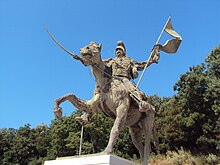Theodoros Kolokotronis
Kolokotronis achieved his greatest success at the 1822 Battle of Dervenakia, where he routed the Ottoman forces under the command of Mahmud Dramali Pasha.
He descended from a family of klephts,[1][5] originally from the historical village of Roupaki at the border of Messenia and Arcadia, located nearby the settlement of Tourkoleka.
The Turks chased the family, which was forced to leave the tower – Kolokotronis was ten years old at the time – and took refuge in Milea, Mani.
[7] His father, Konstantinos Kolokotronis, was a former captain of the Armatoloi in Corinth,[8] who took part in an armed rebellion, the Orlov Revolt, instigated by the administration of Catherine the Great of Russia.
[11] When Zakynthos was occupied by the British, he obtained useful military experience while serving under the command of Richard Church, a philhellene, in the 1st Regiment Greek Light Infantry; in 1810, Kolokotronis was promoted to the rank of major.
[13]Kolokotronis returned to the mainland just prior to the outbreak of the war (officially, 25 March 1821) and formed a confederation of irregular Moreot klepht bands.
Dramali's men plundered the castle the next day, and he was now free to march them toward the coast to resupply (the Greeks had pursued a scorched earth policy, and the large Ottoman force was eating through its food supplies rather quickly).
A devastated Sultan Mahmud II in Constantinople was forced to turn to Muhammad Ali, ruler of the nominally Ottoman pashaluk of Egypt, for help.
Kolokotronis is said to have ridden his horse up the steep slopes of Palamidi to celebrate his victory there; a statue in the town square commemorates the event.
From December 1823 to February 1825, he took part in the civil wars among the various Greek factions; when his party was finally defeated, he was jailed in Hydra with some of his followers in March 1825, and was released only when an Egyptian army under the command of Ibrahim Pasha invaded the Morea.
With his eye on the prize, he burned his way through the Peloponnese, gaining much territory but arousing much hostility in western European public opinion, which in the long run proved disastrous for the Ottomans.
The island of Sphacteria and Navarino had already fallen into Ibrahim's hands, and to make matters worse for Kolokotronis, he still had to be on guard against the machinations of Petros Mavromichalis even as he was bracing himself against the new threat.
When the count was assassinated on 8 October 1831, Kolokotronis created his own administration in support of Prince Otto of Bavaria as a King of Greece.
Then he left to a farm he had outside the city as he writes: As much as I could I paid my debt: I saw my homeland free, I saw what I and my father and my grandfather and my whole generation and all Greeks longed for.
[15] Theodoros Kolokotronis died in 1843 in Athens one day after his son Konstantinos's (Kollinos) wedding and after a feast at the Royal Palace, in presence of King Otto.
He was buried in a family plot in the First Cemetery of Athens, where he remained interred until 1930, when prime minster Eleftherios Venizelos had his bones exhumed and transported to Tripoli.
In addition to the Nafplio statue mentioned earlier, there is another to be seen in Athens, in the forecourt of the Old Parliament building on Stadiou Street, near Syntagma Square.




